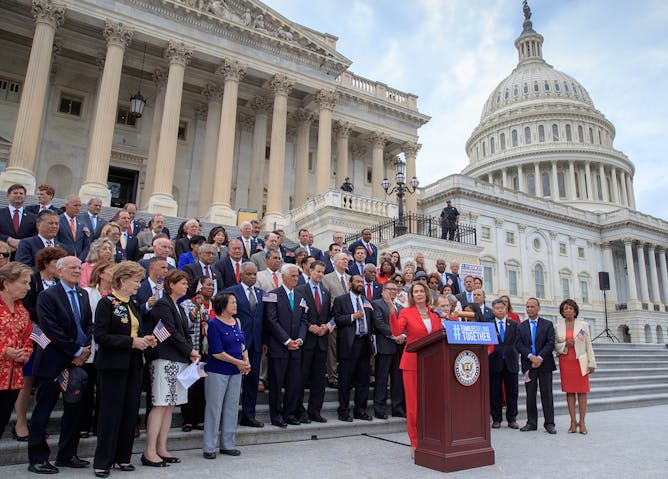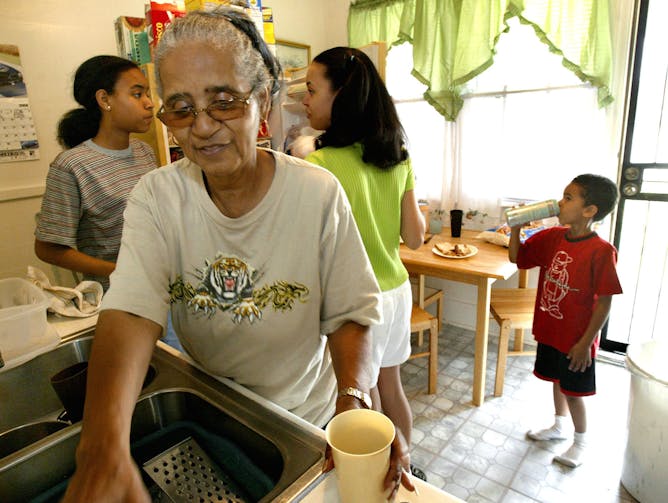|
|
|
Editor's note
|
|
Yesterday’s election changed the balance of power in Congress, with Democrats taking control of the House and Republicans picking up seats in the Senate. Steven Pressman of Colorado State examines two economic issues that will be affected by the results – “NAFTA 2.0” and infrastructure. Bob Britten of West Virginia University identifies the enduring image of the election. Plus: the latest on marijuana legalization and felon voting rights in Florida.
Even though midterm voting is over, threats remain to the U.S. voting system and the solutions must be more than just technical fixes, writes Richard Forno, a cybersecurity scholar at the University of Maryland, Baltimore County. Misinformation and propaganda abound, especially online, and both social media companies and individuals need to get better at identifying what’s fake and what’s real.
Michigan State public policy researcher Natasha Pilkauskas recently discovered that the rate of American kids living in three-generation households – in which kids live with at least one parent and grandparent – has grown. Pilkauskas explores the ramifications for nearly 10 million American kids.
|
Bryan Keogh
Economics + Business Editor
|

|
|
Top stories
|

House Democrats will finally have a say in economic policy.
AP Photo/J. Scott Applewhite
Steven Pressman, Colorado State University
While a divided Congress will likely mean gridlock, there are two economic policies likely to see significant change: trade and infrastructure.
|

As Americans go to the polls, the voting process and the information environment are still not secure.
AP Photo/David Goldman
Richard Forno, University of Maryland, Baltimore County
Protecting democracy requires more than just technical solutions. It includes education, critical thinking and members of society working together to agree on problems and find solutions.
|

In 2016, nearly 10 percent of American kids were living in three-generation households, like this one in Detroit, Michigan.
AP Photo/Paul Sancya
Natasha Pilkauskas, University of Michigan
Over the past 20 years, the number of American households that have grandparents, their kids and their grandkids living under the same roof has nearly doubled.
|
2018 Midterms
|
-
Bob Britten, West Virginia University
Here's a riddle: What's the dominant image of the 2018 election campaign? There really isn't one. But there are many.
-
Daniel J. Mallinson, Pennsylvania State University; Lee Hannah, Wright State University
Two-thirds of all US states now have some kind of legal pot, and support for legalization has never been higher. But ballot initiatives can only take legalization so far, researchers say.
-
Victoria Shineman, University of Pittsburgh
New research shows that when ex-offenders are told they're able to vote, their attitudes about democracy and justice improve.
|
|
Economy + Business
|
-
Warren Sanderson, Stony Brook University (The State University of New York); Sergei Scherbov, International Institute for Applied Systems Analysis (IIASA); Simone Ghislandi, Bocconi University
Most researchers use the UN's Human Development Index to measure each country's progress, but that system has flaws. A new, simplified index aims to do it better.
|
|
|
|
|
|
Most read on site
|
-
Vasudha Narayanan, University of Florida
Born Farrokh Bulsara, Mercury came from a Parsi family that practiced Zoroastrianism, a religion that influenced Judaism, Christianity and Islam.
-
Jennifer Ruef, University of Oregon
Many Americans feel anxiety or dread when it comes to math. A lot of that anxiety starts in childhood.
-
Thomas Kochan, MIT Sloan School of Management
The walkout by thousands of Google employees around the world was historic, both because of who was protesting and what their demands were. It may even mark the start of something new.
|
|
Today’s chart
|
-

 |
Suzanne Robbins
University of Florida
|
| | | |
| |
|
|
|
|
|
|
|